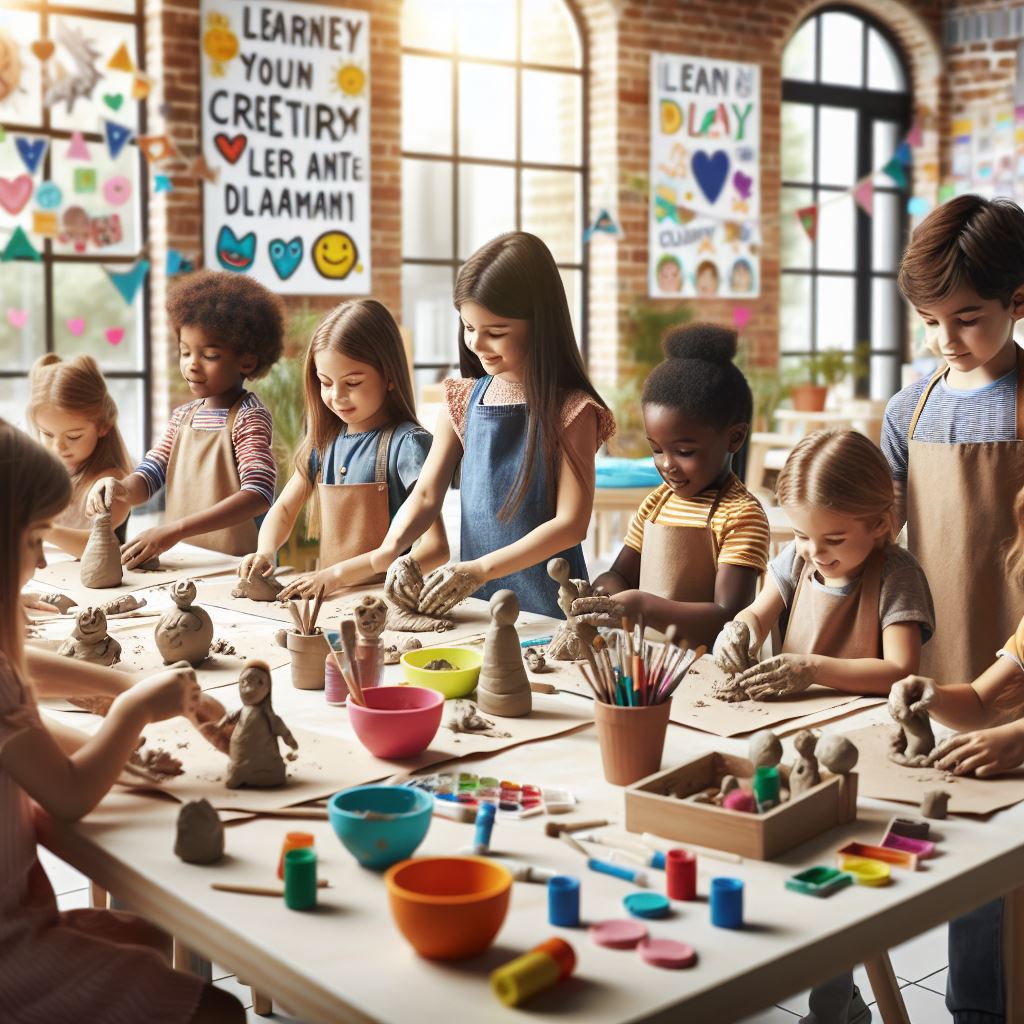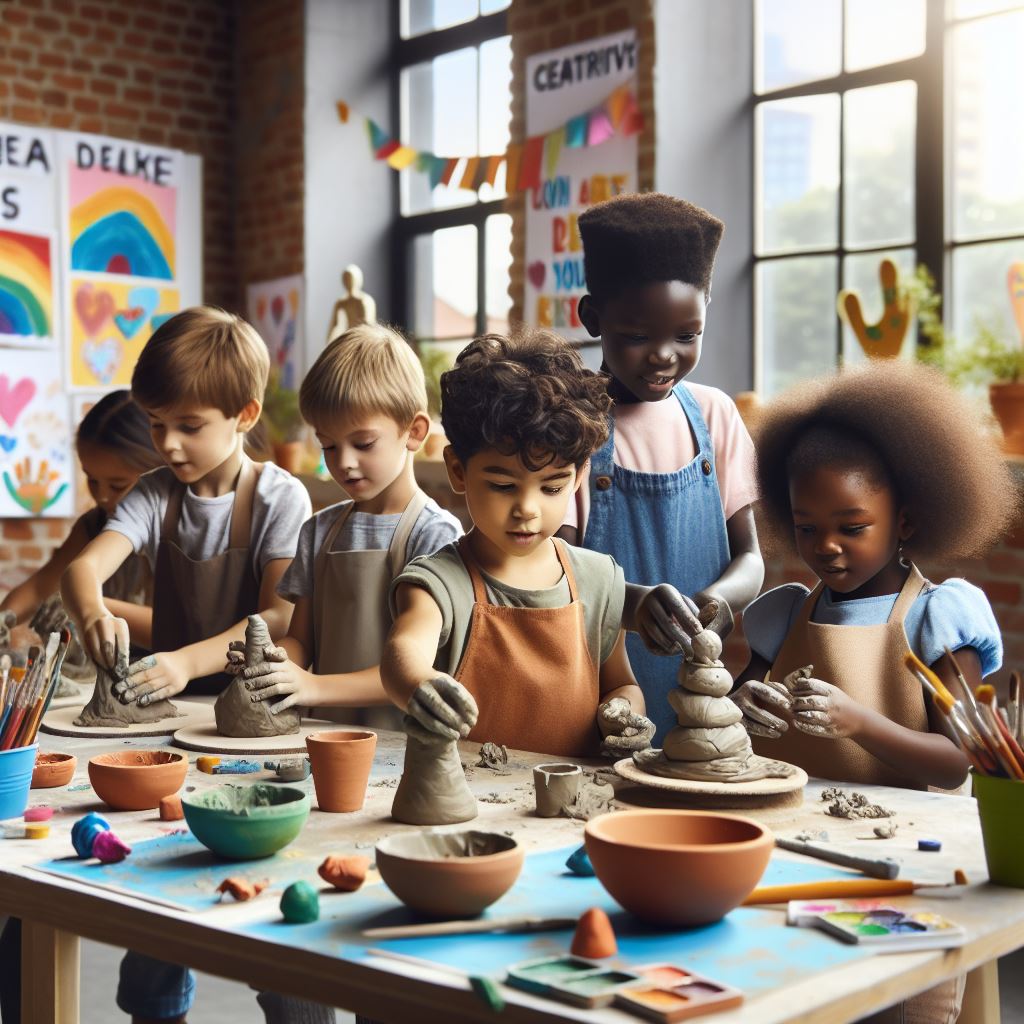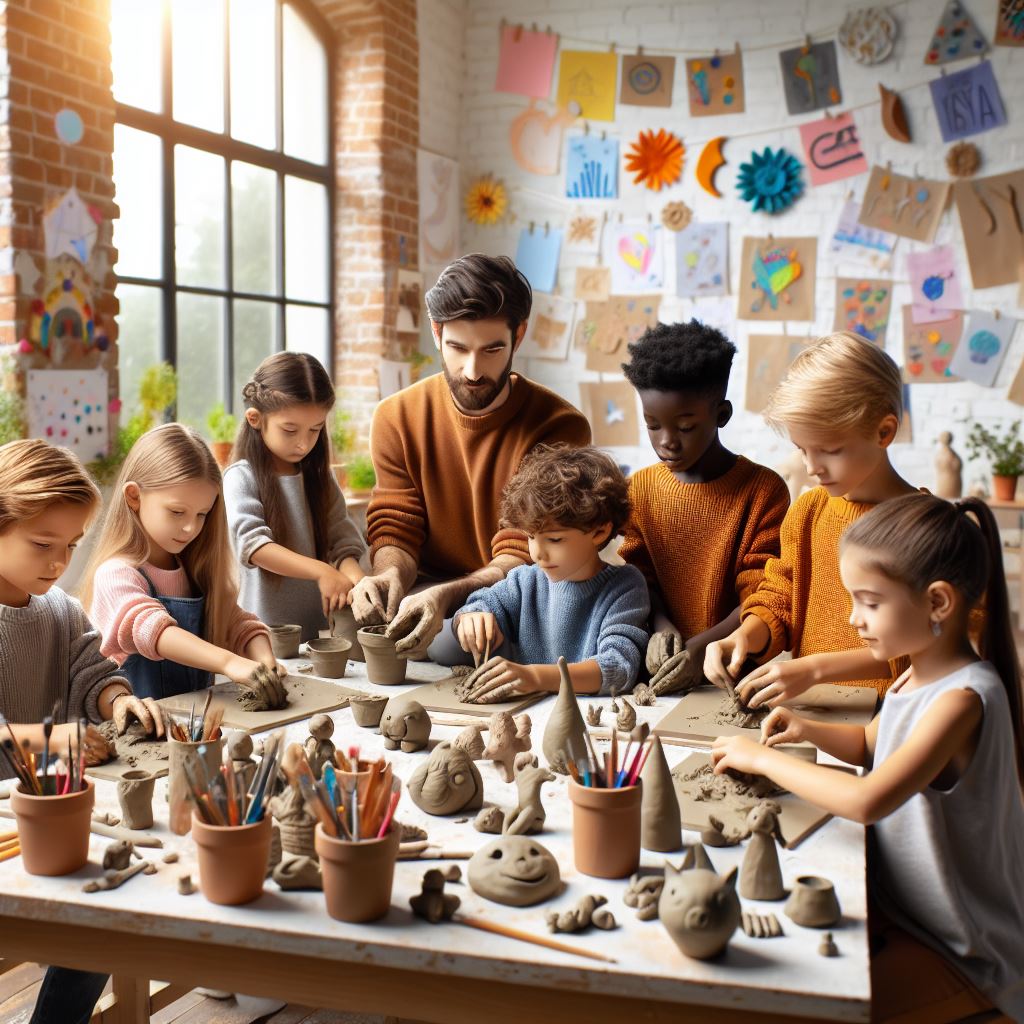Table Of Contents
- 1 Sculpting with Clay: A Fun and Creative Activity for Kids
- 1.1 Benefits of Sculpting with Clay for Children‘s Activities
- 1.2 Suitable Clay for Children’s Activities:
- 1.3 Engaging Clay Sculpting Activities for Children:
- 1.4 Exploring the Versatility of Clay:
- 1.5 Essential Tools for Sculpting with Clay:
- 1.6 The Art of Clay Preparation:
- 1.7 1. Sculpting Simple Shapes: Mastering the Basics of Clay Modeling
- 1.8 2. Creating Figurines and Miniature Objects:
- 1.9 3. Embellishing Your Creations:
- 1.10 Therapeutic Benefits of Clay Sculpting:
- 1.11 Creative Rewards of Clay Sculpting:
- 1.12 Frequently Asked Questions (FAQs):
- 1.13 Conclusion:
Sculpting with Clay: A Fun and Creative Activity for Kids

Clay sculpting is a captivating and engaging activity that offers a multitude of benefits for children of all ages. It’s a tactile and sensory experience that nurtures creativity, imagination, and problem-solving skills. As children mold and shape the clay, they engage in a meditative practice that promotes relaxation, focus, and stress relief. Moreover, clay sculpting provides an opportunity for self-expression, allowing children to convey their thoughts, emotions, and experiences through their creations.
Benefits of Sculpting with Clay for Children‘s Activities
-
Creativity and Imagination: Clay sculpting encourages children to tap into their limitless imagination, transforming simple lumps of clay into unique and expressive pieces of art.
-
Fine Motor Skills Development: Kneading, rolling, and shaping clay strengthens hand and finger muscles, improving fine motor skills essential for everyday tasks.
-
Problem-Solving and Decision-Making: Sculpting challenges children to think creatively and solve problems as they work towards their desired outcome.
-
Self-Expression and Emotional Processing: Clay provides a medium for children to express their emotions, thoughts, and experiences in a non-verbal and therapeutic way.
-
Sensory Exploration and Tactile Engagement: The tactile nature of clay sculpting stimulates the senses, promoting relaxation, mindfulness, and stress reduction.
-
Concentration and Focus: Sculpting requires focused attention and concentration, enhancing children’s ability to stay engaged in a task.
-
Self-Confidence and Achievement: Completing a clay sculpture instills a sense of accomplishment and boosts self-confidence in children’s abilities.
Suitable Clay for Children’s Activities:
-
Air-Dry Clay: This non-toxic clay is easy to use and requires no firing, making it ideal for young children.
-
Polymer Clay: This versatile clay comes in a wide range of colors and can be baked in an oven to harden.
-
Play Dough: This soft and pliable dough is great for sensory play and developing fine motor skills.
Engaging Clay Sculpting Activities for Children:

-
Simple Shapes and Animals: Guide children in sculpting basic shapes like spheres, cubes, and cylinders, and progress to creating simple animals.
-
Food Sculptures: Encourage children to sculpt their favorite foods, fostering creativity and imagination.
-
Nature-Inspired Creations: Draw inspiration from nature by sculpting leaves, flowers, and animals.
-
Clay Jewelry: Create unique clay beads, pendants, and bracelets for personalized accessories.
-
Collaborative Clay Projects: Engage children in group clay sculpting projects, promoting teamwork and communication.
-
Clay Stop Motion Animation: Create a simple stop motion animation using clay figures, fostering creativity and storytelling skills.
-
Clay Painting and Glazing: Once sculptures are dry, let children unleash their creativity by painting and glazing them.
-
Clay Sculpting Workshops and Classes: Enroll children in clay sculpting workshops or classes for more in-depth instruction and guidance.
Exploring the Versatility of Clay:
Clay comes in a variety of forms, each with unique properties and applications. Understanding the characteristics of different clays will help you select the most suitable material for your creative endeavors.
-
Air-dry Clay: This non-toxic clay is easy to use and requires no firing, making it ideal for beginners. It is soft and pliable, ideal for sculpting simple shapes and intricate details.
-
Polymer Clay: This versatile clay comes in a wide range of colors and can be baked in an oven to harden. It is well-suited for sculpting intricate designs, jewelry making, and creating miniature objects.
-
Earthenware Clay: This traditional and affordable clay is fired at low temperatures. It is known for its porous, rustic texture and warm, earthy tones. Earthenware clay is commonly used for creating functional pottery pieces, such as mugs, bowls, and decorative items.
-
Porcelain Clay: This refined and elegant clay is fired at high temperatures. It is prized for its smooth, translucent appearance and delicate strength. Porcelain clay is often used for creating fine china, decorative figurines, and intricate sculptures.
-
Stoneware Clay: This versatile and durable clay is fired at medium temperatures. It is known for its dense, vitrified body and resistance to chipping and breakage. Stoneware clay is commonly used for creating functional pottery, such as dinnerware, cookware, and outdoor sculptures.
Essential Tools for Sculpting with Clay:

A well-equipped clay sculpting toolbox will enhance your creative process and allow you to tackle a variety of projects with ease. Here are some essential tools to consider:
-
Pottery Wheels: Provide a rotating platform for shaping clay, allowing for creating symmetrical forms and intricate details.
-
Sculpting Knives: Come in various shapes and sizes for cutting, shaping, and refining clay forms.
-
Clay Ribbons: Flexible tools used for smoothing, shaping, and creating textures on clay surfaces.
-
Rolling Pins: Used for flattening, thinning, and creating even layers of clay.
-
Sponge: A damp sponge is used for smoothing surfaces, removing excess clay, and blending different clay colors.
-
Sculpting Tools Set: Includes a variety of tools for sculpting, carving, and adding intricate details to clay creations.
The Art of Clay Preparation:
Before embarking on your sculpting journey, proper clay preparation is essential. Kneading, rolling, and shaping the clay will ensure it is smooth, pliable, and ready to be molded into your desired forms.
1. Kneading:
Remove air bubbles, distribute moisture evenly, and make the clay soft and workable by kneading it. Hold the clay in your hands and forcefully knead it until it becomes smooth and elastic.
2. Rolling:
Create even sheets of clay by rolling it on a flat surface. Use a rolling pin to roll the clay into sheets of the desired thickness.
3. Shaping:
Form the basic shapes of your creation by shaping the clay. Use your hands, sculpting tools, and pottery wheels to mold the clay into the desired forms.
With these essential tools and techniques, you’re ready to embark on your clay sculpting journey. Embrace the tactile experience, channel your creativity, and transform simple lumps of clay into unique and expressive works of art.
1. Sculpting Simple Shapes: Mastering the Basics of Clay Modeling
The foundation of clay sculpting lies in mastering basic shapes like spheres, cubes, and cylinders. These fundamental forms serve as building blocks for more intricate creations.
a. Spheres:
-
Roll a lump of clay into a ball, ensuring it is smooth and evenly shaped.
-
Use your hands to gently press and reshape the clay until it forms a perfect sphere.
b. Cubes:
-
Start with a rectangular block of clay.
-
Use a sculpting knife to cut the block into a perfect cube, ensuring all sides are straight and perpendicular.
c. Cylinders:
-
Roll a lump of clay into a snake-like shape.
-
Use your fingers to gently press and roll the clay until it forms a smooth, even cylinder.
2. Creating Figurines and Miniature Objects:
With the basics mastered, it’s time to bring life to your creations by sculpting figurines and miniature objects. Draw inspiration from everyday objects or your own imagination.
a. Figurines:
-
Start by creating the basic body shape of your figurine.
-
Use simple shapes like spheres, cylinders, and cones to form the head, torso, limbs, and other body parts.
-
Refine the shapes and add details like facial features, clothing, and accessories.
b. Miniature Objects:
-
Sculpt miniature versions of everyday objects or create unique pieces.
-
Use sculpting tools to carefully carve out shapes, add intricate details, and create a polished finish.
3. Embellishing Your Creations:
Once your creations are sculpted to your satisfaction, it’s time to add embellishments for a polished and personalized touch.
a. Painting:
-
Use acrylic paints to add color and vibrancy to your creations.
-
Apply paint carefully with brushes, sponges, or other tools to achieve the desired effect.
b. Glazing:
-
Apply glaze evenly with a brush to provide a protective and decorative layer to your clay creations.
-
Follow the manufacturer’s instructions for drying and firing to ensure proper adhesion.
c. Firing:
-
If using polymer clay, follow the manufacturer’s instructions for baking your creations in an oven to harden them.
-
For earthenware, stoneware, and porcelain clays, firing in a kiln is essential to harden and vitrify the clay.
With these embellishing techniques, you’ll transform your clay creations into unique works of art, ready to be displayed, cherished, and gifted.
Therapeutic Benefits of Clay Sculpting:
-
Stress Relief and Relaxation: The tactile nature of clay sculpting engages the senses, promoting relaxation and mindfulness. As individuals focus on the process of shaping and molding the clay, their minds unwind and stress dissipates.
-
Self-Expression and Emotional Processing: Clay provides a medium for individuals to express their emotions, thoughts, and experiences in a non-verbal and therapeutic way. Sculpting can serve as a healthy outlet for processing difficult emotions and promoting emotional well-being.
-
Fine Motor Skills Development: Kneading, rolling, and shaping clay strengthen hand and finger muscles, improving fine motor skills essential for everyday tasks. This is particularly beneficial for children and individuals with motor skill challenges.
-
Cognitive Enhancement: Clay sculpting engages the brain’s creative centers, promoting problem-solving skills, decision-making abilities, and spatial reasoning.
-
Sense of Accomplishment and Self-Confidence: Completing a clay sculpture instills a sense of accomplishment and boosts self-confidence in individuals’ abilities.
Creative Rewards of Clay Sculpting:
-
Creativity and Imagination Exploration: Clay sculpting provides a limitless canvas for creativity, allowing individuals to transform their imagination into tangible forms.
-
Artistic Expression and Personal Growth: Clay sculpting fosters artistic expression, enabling individuals to discover their unique artistic style and personal voice.
-
Sensory Exploration and Tactile Engagement: The tactile nature of clay sculpting stimulates the senses, promoting sensory exploration and a deeper connection with the creative process.
-
Mindfulness and Focus: Clay sculpting requires focused attention and concentration, enhancing individuals’ ability to stay engaged in a task.
-
Creative Problem-Solving and Resourcefulness: Clay sculpting challenges individuals to think creatively and find solutions to overcome sculpting obstacles.
Frequently Asked Questions (FAQs):
Q: What is the best type of clay for beginners?
Air-dry clay is an excellent choice for beginners due to its ease of use and no firing requirement. It is soft and pliable, making it ideal for sculpting simple shapes and intricate details.
Q: What tools do I need for clay sculpting?
Essential tools for clay sculpting include pottery wheels (for creating symmetrical forms), sculpting knives, clay ribbons, rolling pins, sponges, and a sculpting tools set for adding intricate details.
Q: How do I prepare clay for sculpting?
Knead the clay to remove air bubbles, distribute moisture evenly, and make it soft and workable. Roll the clay to create even sheets and use sculpting tools to shape the clay into the desired forms.
Q: How do I add color and embellishments to my clay creations?
Use acrylic paints to add color and vibrancy. Apply glaze evenly with a brush for a protective and decorative layer. If using polymer clay, follow the manufacturer’s instructions for baking your creations in an oven to harden them. For earthenware, stoneware, and porcelain clays, firing in a kiln is essential to harden and vitrify the clay.
Q: Where can I learn more about clay sculpting techniques?
Numerous resources are available to guide your clay sculpting journey, including books, online tutorials, and workshops. Joining local art groups or online forums can connect you with fellow clay enthusiasts for support and inspiration.
Conclusion:
Clay sculpting is a captivating and rewarding activity that offers a multitude of benefits for individuals of all ages. It nurtures creativity, imagination, fine motor skills, self-expression, and problem-solving abilities, while providing a therapeutic and sensory-enriching experience. Embrace the joy of sculpting with clay, and embark on a journey of creative exploration and self-discovery.